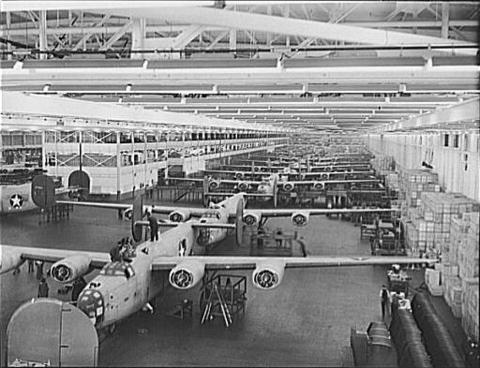Celebrating Labor Day 2012: Willow Run

Observed on the first Monday in September, Labor Day is a U.S. Federal holiday honoring the contributions of America's workers. In celebration of Labor Day 2012 we will take a look at one of the biggest and most spectacular industrial efforts in U.S. history: the Willow Run Manufacturing Plant.
During the massive rearmament drive ordered by U.S. President Franklin Delano Roosevelt prior to the U.S. entry into World War II aircraft production quickly rose to the forefront of manufacturing efforts - particularly the production of heavy bombers. Big four-engine "heavy" bombers ranked among the Second World War's most complex and expensive war machines. Accordingly, assembling such aircraft required access to tremendous resources in skilled labor and material. Early in 1941 one of the two most important U.S. heavy bombers, the B-24 "Liberator", had begun production in San Diego California. However, this manufacturing plant was turning out only one bomber per day, and more manufacturing capacity was needed.
In stepped the Ford Motor Company, with Henry Ford's production chief (Charles Sorenson) playing a pivotal role in pushing along the idea that even such enormous aircraft, with over 100,000 parts, could be built in the same efficient manner one built 15,000 part cars of the day. With this idea in mind, during February of 1941 Ford went ahead and bought additional land near a plot he already owned between Ypsilanti and Belleville Michigan along the Willow Run Creek. Construction of a world class manufacturing facility began shortly thereafter in the spring of 1941.
By the fall of 1941 construction had been completed on the world's largest manufacturing facility, featuring over 3.5 million square feet of factory floor space. Dubbed "Willow Run", in October of 1942 the first B-24 bomber rolled off the plant's assembly line. By December 1943 some 365 B-24's a month (see picture) were being produced at Willow Run. In 1944 monthly output rose to 650, and by 1945 nearly three quarters of all B-24's were built at Willow Run with 8,685 manufactured in total before B-24 production was shut down in 1945.
At its peak over 40,000 men and women built B-24's at Willow Run, making, on average, 95 cents to $1.60 per hour in daily nine hour shifts (at its peak Willow Run ran two shifts per day). Workers came from across America, including thousands from the south, and all walks of life - including experienced auto workers but also teacher's, waitresses, and others who had to be trained on the job. Housing was not exactly what one would expect, with $5 per week rooms in huge dormitories built to house thousands of workers. Working long days, and going "home" to such crowded impersonal housing meant turnover was high in spite of the good wages. Nevertheless, these workers overwhelmingly did their jobs with skill and dedication. It is to them and millions of others like them that we salute and offer our heartfelt thanks on Labor Day 2012.



Post new comment